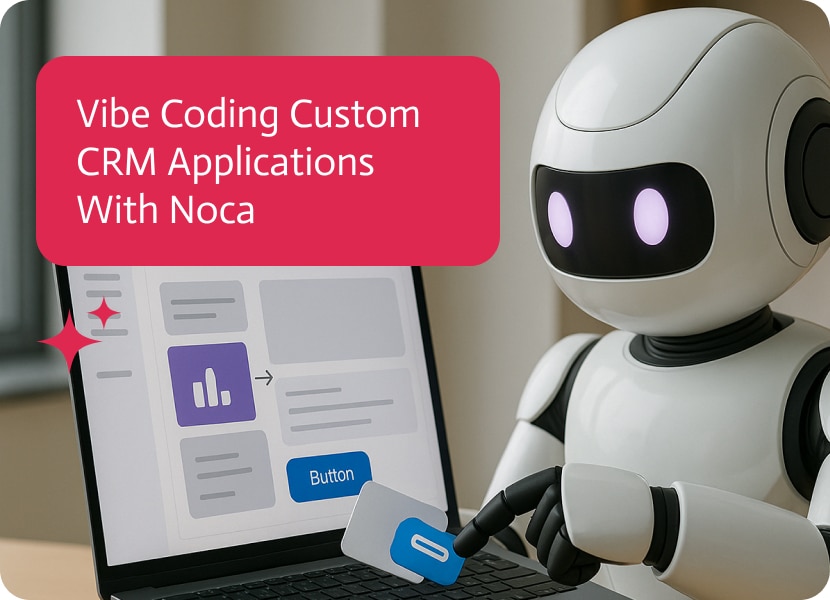

Vibe Coding Custom CRM Applications With Noca
The functions provided by customer relationship management (CRM) have proven to be an essential instrument in company operations. They’re where we keep important info, track deals, and give companies the insight they need to grow. Yet, while they are incredibly powerful, they’re often bloated with features most teams never use, not to mention missing specific tools a business really needs. This is where Noca’s vibe coding platform steps in, rewriting and changing how we build CRM experiences.
Now, rather than messing around with clunky modules or waiting weeks for developers to spin up a custom extension, Noca allows teams to design their own applications in minutes. The method? Vibe coding, a prompt to app approach that builds functional, front-end apps by simply describing them in plain English. Just think about asking your CRM to give you a lead tracker tailored to your sales process and, within minutes, having a polished app ready to plug in. Well, that’s exactly what Noca does and how they’re making a difference.
What is Vibe Coding for Custom CRM Applications?
Before diving into CRM specifics, let’s clear up what vibe coding actually is. Traditional coding involved a lot of syntax, frameworks, and complex libraries. No-code platforms, which came later, tried to make this easier through drag-and-drop interfaces. But vibe coding takes the next leap: you tell it what you want in plain words, and the platform puts it together for you right away.
It’s like briefing a designer without ever touching any tools or giving your developer requirements without the back-and-forth. You don’t say, “Build a component with an API hook to Salesforce.” You say, “Make a lead scoring dashboard for my sales team that uses our Salesforce data.” And the app, seemingly miraculously, appears. Fully functional, styled, and integrated.
In practice, this means anyone from a sales manager to a customer support rep can create their own CRM enhancements without knowing a line of code.
Why Noca is Best for Custom CRM Applications
CCRMs are meant to streamline relationships, but often, businesses change their processes to fit the software, not the other way around. Noca flips that paradigm, so rather than dealing with a rigid system, they’ve given businesses the ability to mold CRM tools around their exact workflows. With features like prompt to bot, teams can turn simple natural-language instructions into automated CRM actions, making customization even faster and more flexible.
Here’s why Noca stands out:
Direct CRM Compatibility: Noca already integrates with leading systems, such as Salesforce, while new ones are being added regularly.
No-Code Flexibility: Beyond supported CRMs, Noca can connect with countless others via APIs and no-code integration methods.
Speed of Deployment: Go from idea to live application in minutes instead of months.
Scalable Customization: Build apps that serve niche purposes, whether it’s managing account renewals, tracking service tickets, or consolidating client info.
Examples of Custom CRM Applications Using Noca
One of the strongest proofs of Noca’s value is in the types of applications teams can create. Let’s walk through a few examples of the possibilities:
1. Custom Lead Scoring App
Sales teams live and die by leads, but out-of-the-box CRM lead scoring often misses the mark. With Noca, you can build an app that tailors scoring logic to your unique customer journey.
- Assign weights to engagement signals like demo attendance, content downloads, or email responses.
- Integrate directly with loads of CRM data so that scores are updated in real time.
- Gift reps with a dashboard showing leads that have the most potential this week, not just in theory.
The result? Salespeople spend less time on the wrong leads and more time closing deals.
2. Support Ticket Tracker
Customer service teams usually have to deal with a plethora of tools, such as email inboxes, ticketing systems, and chat logs. With Noca, they’re able consolidate these into a single support tracker app which links directly to CRM data.
- Track open cases by using filters for urgency and priority.
- Surface customer history directly in the ticket view so agents see the bigger picture.
- Automate follow-up reminders and define escalation paths.
This creates smoother workflows and speeds up resolution times, improving customer experience while also reducing agent stress in the process.
3. Client 360 View App
The holy grail in CRM has to be the “single view of the customer.” But all too often, you’ll need to find information that’s strewn across sales, service, and marketing tools. Noca’s vibe coding makes it simple to create a Client 360 app that aids in grouping everything together neatly.
- Aggregate all client interactions: support chats, billing history, sales calls
- Data is presented in an intuitive interface that’s been designed specifically for agents.
- Enable quick personalization during interactions, because purchase history helps with recommending the right upsell.
Instead of wasting time clicking through multiple tabs, teams can see the entire customer story in one place.
How Noca Improves Custom CRM Applications Workflow
Traditionally, creating these kinds of apps required writing a business case. Handing requirements to IT or external developers. Waiting weeks or months for delivery. Testing and reworking until it vaguely resembled the initial request.
Noca eliminates the delays. By allowing frontline teams to build apps themselves, the development cycle shrinks dramatically. Want to test a new lead scoring formula? Spin up an app today, run it for a week, then apply modifications in response to real-world results.
This “fail fast, win faster” approach means organizations don’t have to gamble months of resources on tools that might not work.
Custom CRM Applications Integrations and Technical Details
While vibe coding emphasizes simplicity, Noca is powerful under the hood thanks to:
- Pre-Built Connectors: Direct integrations with Salesforce, other leading CRMs, and HubSpot.
- API Support: For CRMs not yet directly supported, Noca offers robust no-code connectors to other CRMs through APIs.
- Scalable Architecture: Apps built on Noca can handle enterprise-level usage without imploding because of data loads.
- Updated Continuously: The library of integrations grows constantly, ensuring businesses stay future-ready.
In short, Noca’s ease of use doesn’t mean sacrificing depth. IT teams can still connect to legacy systems, giving organizations the best of both worlds.
Business Benefits Noca in CRM
So what’s in it for companies, and what can they gain from vibe coding CRM applications? Plenty:
- Faster Time-to-Market: Launch apps in days instead of quarters.
- Lower Development Costs: Empower non-technical staff to build apps without relying on developer resources.
- Increased Productivity: Provide teams with tools to build exact workflows, reducing wasted clicks and workarounds.
- Better Customer Experiences: Equip sales and support teams with more relevant, personalized tools.
- Continuous Innovation: Play around with new processes quickly and safely, without disrupting native systems.
Ultimately, Noca doesn’t just add apps, it changes businesses’ perception of their CRM ecosystem.
Teams Who Benefit From Custom CRM Applications
While any company using a CRM will benefit, a large percentage of teams will feel the impact more immediately:
- Sales Departments: Looking for better forecasting and lead monitoring.
- Customer Support Teams: Needing streamlined case efficient case handling and swift customer resolutions.
- Account Managers: Wanting 360-degree client views and smarter renewal tracking.
- Marketing Teams: Looking for CRM-record-aligned personalized campaign data.
- SMBs and Enterprises Alike: Noca is scalable, making it suitable for use by both small and large teams.
The common denominator is your CRM, if it feels like it’s working against you rather than for you, Noca can turn that around.
CRMs Future With Vibe Coding
Looking ahead, the fusion of vibe coding and CRM systems will completely change customer relationship management. Businesses will no longer have to choose between generic, out-of-the-box features and costly, slow-to-build customizations. Instead, they’ll be able to tailor CRM apps on demand, empowering employees to solve problems as they arise.
Noca is leading this shift. Its consistent updating, expanding integrations, and commitment to simplifying development are leading the way in the next era of CRM evolution.
Imagine a future where a customer service manager notices a new trend and, the same day, creates an app for it. Or where a sales director refines a lead dashboard weekly thanks to feedback, without submitting a single IT ticket. That’s not just possible with Noca, it’s already happening.
Final Thoughts on Custom CRM Applications
CRMs are indispensable, but they’ve long suffered from complexity, rigidity, and being too slow to adapt. Noca’s vibe-coding platform changes that by handing customization back to the people who actually use the system. And now, with AI agent layered into the workflow, teams can go beyond just building custom tools ,they can automate the work inside them.
Whether it’s an AI-driven lead scoring app, a support ticket tracker that assigns and updates itself, or a Client 360 view enriched by autonomous data-gathering agents, the opportunities aren’t just endless, they’re finally practical.


